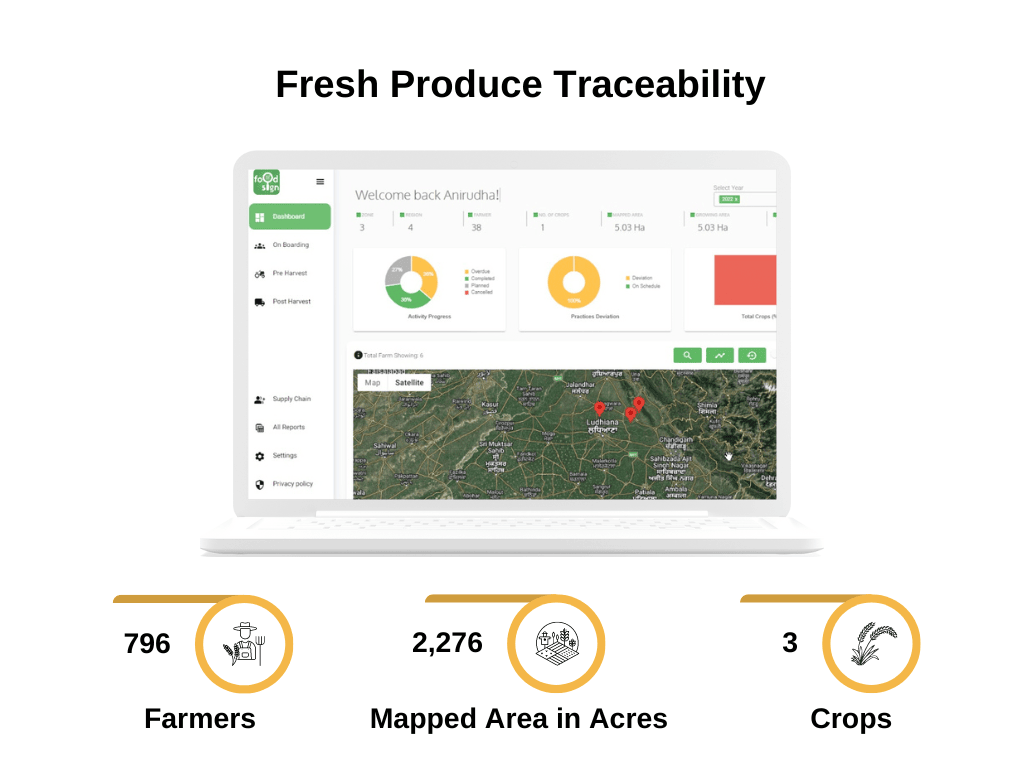Contact: +91 99725 24322 |
Menu
Menu
A major agribusiness exporter was able to achieve end-to-end supply chain traceability, ensuring quality control, compliance with export standards, and equitable opportunities for farmers with TraceX’s farm management platform leading to expanded market reach and benefits for all stakeholders.

A major exporter in the agribusiness sector is dedicated to empowering farmers and providing them access to global markets. They have already provided benefits to over a million farmers and plans to scale up to 5 million by 2024.
They grow a diverse range of crops from staple crops such as rice and maize to pulses, fruits and vegetables. With a focus on quality and sustainability, this exporter also supplies baby corn, chillies, bananas and grapes to markets in Europe and the Gulf region.
Agribusiness
India- Haryana, Bihar, UP, Odisha and West Bengal
Supply chain digitization , ensuring transparency and meeting export standards for crops using Farm Management Platform
TraceX farm management platform digitally transforms the food and agriculture ecosystem, ensuring a clean, credible, and traceable supply chain. By connecting various stakeholders securely, it facilitates the exchange of verifiable and auditable data, fostering mutual trust, accountability, and transparency. The comprehensive solution includes a multilingual, offline-enabled mobile app for farm management and a web application for post-harvest management, supply chain collaboration, and blockchain-based traceability.
Explore our Farm Management Platform
The farm and farmer management feature in the platform encompasses various functionalities aimed at efficiently onboarding and managing farmers within the system.
This involves capturing essential details such as plot ID, survey number, water source, soil type, address details, production practices, and landholding information. Farmers are individually registered via the mobile app or web platform, and their data can also be imported in bulk using Excel templates.
In addition to basic information, critical details like Global GAP Number, Government Unique Code, and Farmer Contract Agreement are captured for each farmer, enhancing traceability and compliance.
Geo-coordinates of farm boundaries are plotted by field officers during farm visits, allowing for accurate mapping of farm plots. This feature provides visibility into farm boundaries and crop areas, facilitating effective farm management and monitoring.
Farmer groups are created based on geographic areas and managed by field staff throughout the crop lifecycle. The organization’s team is responsible for creating and managing these groups, ensuring streamlined coordination and communication between farmers and field officers.
The Crop Master feature in the project facilitates comprehensive crop cycle digitization and management across various crops grown by farmers in different geographies.
Project managers or crop planning heads can configure different crop varieties grown by farmers for the current season. This includes associating crop varieties with specific farmer groups, defining crop measurements, input plans, cost of production, and other preferences.
Users can create recommended input plans for crop varieties based on crop activity types, input categories, products, dosages, and multiple input options. This feature helps in planning and managing inputs effectively throughout the crop cycle.
Users can develop crop calendars for the entire crop cycle using Package of Practices (POP) associated with specific crop varieties and input plans. This feature ensures adherence to recommended agricultural practices, optimizing crop yields and quality.
Users can set up harvest estimates and patterns for each configured crop variety for the required crop season or year. This includes defining harvest types, whether single or multi-harvest, and planning harvest activities accordingly.
The Project/Operation Manager (Packhouse) will establish a Process Master for each SKU (Finished Goods) according to business requirements.
Raw produce received from farmers is cleaned. The produce is sorted and graded based on physical, chemical, and other parameters set by organizational guidelines. Users can select individual or multiple batches for grading. Details are entered in the input and output sections, with a summary page for verification. Upon submission, a new batch is created.
Graded produce is packed using pre-determined packaging materials configured in the Process Master. Users select the required batch of inputs and specify quantity details. Users select the output product SKU and quantity details for packing.
The raw produce procured from farmers will be transferred from their storage facilities to a designated warehouse for further processing or necessary actions.
At the warehouse, the admin will receive the batches sent from the farmers’ plots, verifying the actual sales details through the view receipt, Accept GRN, and Buy functions. This process ensures transparency and accuracy in recording the received quantities.
The procurement manager determines the price of the produce, which will be used to calculate the final net-off value for the farmer. This amount will account for the cost of inputs distributed to the farmer for the crop season, ensuring they receive a fair and accurate payment from the organization.



We use cookies on our website to give you the most relevant experience by remembering your preferences and repeat visits. By clicking “Accept All”, you consent to the use of ALL the cookies. However, you may visit "Cookie Settings" to provide a controlled consent.
| Cookie | Duration | Description |
|---|---|---|
| cookielawinfo-checkbox-analytics | 11 months | This cookie is set by GDPR Cookie Consent plugin. The cookie is used to store the user consent for the cookies in the category "Analytics". |
| cookielawinfo-checkbox-functional | 11 months | The cookie is set by GDPR cookie consent to record the user consent for the cookies in the category "Functional". |
| cookielawinfo-checkbox-necessary | 11 months | This cookie is set by GDPR Cookie Consent plugin. The cookies is used to store the user consent for the cookies in the category "Necessary". |
| cookielawinfo-checkbox-others | 11 months | This cookie is set by GDPR Cookie Consent plugin. The cookie is used to store the user consent for the cookies in the category "Other. |
| cookielawinfo-checkbox-performance | 11 months | This cookie is set by GDPR Cookie Consent plugin. The cookie is used to store the user consent for the cookies in the category "Performance". |
| viewed_cookie_policy | 11 months | The cookie is set by the GDPR Cookie Consent plugin and is used to store whether or not user has consented to the use of cookies. It does not store any personal data. |
WhatsApp us
Your Blueprint for Traceable & Sustainable Supply Chain

The countdown has started. Less than 100 days remain to be compliant. Don’t miss out on your chance to grab access to our early bird offer!
Your essential compliance guide